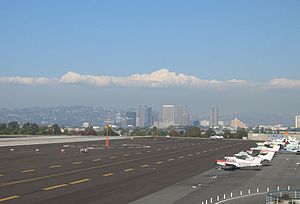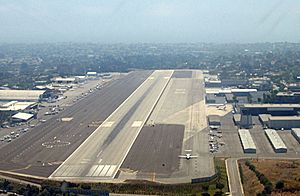Santa Monica Airport facts for kids
Quick facts for kids
Santa Monica Airport
Santa Monica Municipal Airport
Clover Field
|
|||||||||||
|---|---|---|---|---|---|---|---|---|---|---|---|

2006 USGS airphoto
|
|||||||||||
| Summary | |||||||||||
| Airport type | Public | ||||||||||
| Owner | City of Santa Monica | ||||||||||
| Operator | Santa Monica Airport Commission | ||||||||||
| Serves | Southern California | ||||||||||
| Location | Santa Monica and Mar Vista, Los Angeles, California, U.S. | ||||||||||
| Opened | 15 April 1923 | ||||||||||
| Elevation AMSL | 177 ft / 53.9 m | ||||||||||
| Coordinates | 34°00′57″N 118°27′05″W / 34.01583°N 118.45139°W | ||||||||||
| Website | Official website: http://www.smgov.net/departments/airport/ | ||||||||||
| Map | |||||||||||
| Runway | |||||||||||
|
|||||||||||
| [[Helipad|]] | |||||||||||
|
|||||||||||
|
Source: Federal Aviation Administration,
|
|||||||||||
Santa Monica Airport (IATA: SMO, ICAO: KSMO, FAA LID: SMO) (Santa Monica Municipal Airport) is a general aviation airport largely in Santa Monica, California, United States. The airport is about 2 miles (3 km) from the Pacific Ocean (Santa Monica Bay) and 6 miles (10 km) north of Los Angeles International Airport. The FAA's National Plan of Integrated Airport Systems for 2009–2013 categorized it as a reliever airport. The airport is scheduled to remain open until 2028. Santa Monica Airport covers a total of 215 acres (87 ha) of land.
One of the airport's former hangars, the Barker Hangar, is in use as a public events venue, and is commonly used for a number of televised awards ceremonies and concerts. It is also currently being used as a small-scale supermarket set for the current version of Supermarket Sweep.
Contents
History
Early history
Originally Clover Field, after World War I aviator 2nd lieutenant Greayer "Grubby" Clover, the airport was the home of the Douglas Aircraft company.
The first circumnavigation of the world by air, accomplished by the U.S. Army in a fleet of special custom built aircraft named the Douglas World Cruiser, took off from Clover Field on St. Patrick's Day, March 17, 1924, and returned there after some 28,000 miles (45,000 km).
Cloverfield Boulevard — which confuses the field's naming for a crop of green rather than a fallen soldier — is a remnant of the airport's original name, as is the name of the Cloverfield film series, which derives its name from that road.
World War II
Clover Field was once the site of the Army's 40th Division Aviation, 115th Observation Squadron and became a Distribution Center after World War II. Douglas Aircraft Company was headquartered adjacent to Clover Field. Among other important aircraft built there, Douglas manufactured the entire Douglas Commercial "DC" series of reciprocating-engine-powered airliners including the DC-1 (a prototype), DC-2, DC-3, DC-4, DC-5 (only 12 built), DC-6 and DC-7. During World War II, B-18 Bolo and B-18A bombers and thousands of C-47 (military version of the DC-3) and C-54 (later the civilian DC-4) military transports were built at Santa Monica, during which time the airport area was cleverly disguised from the air with the construction of a false "town" (built with the help of Hollywood craftsmen) suspended atop it.
Post-World War II
In 1958, Donald Douglas asked the city to lengthen the airport's runway so that Douglas Aircraft could produce and test the DC-8 there. The city, bowing to objections of residents, refused to do so, and Douglas closed a plant that had employed 44,000 workers in World War II, moving airliner production to Long Beach Airport.
Operations

The airport has a control tower. On average, it handled 296 operations a day (for the 12 months – ended July 2011. Traffic decreased to 83,381 annual operations in 2014.
As the Santa Monica Airport is one of many general aviation airports in the nation that is surrounded on some sides by residential development, the City of Santa Monica aggressively enforces one of the most stringent noise ordinances in the nation. In addition to responding to the community's noise concerns and enforcing the City's Aircraft Noise Ordinance, which includes a maximum allowable noise level, curfew hours and certain operational limitations, airport staff is involved in a variety of supplementary activities intended to reduce the overall impact of aircraft operations on the residential areas surrounding the airport. The following procedures and limitations are enforced in accordance with the noise ordinance. Violations may result in the imposition of fines and/or exclusion from Santa Monica Airport.
- Maximum Noise Level – A maximum noise level of 95.0 dBA Single Event Noise Exposure Level, measured at noise monitor sites 1,500 feet from each end of the runway, is enforced 24 hours a day, 7 days a week. There are no additional noise monitoring stations along the flight pattern, which is routed entirely over residential neighborhoods.
- Night Departure Curfew – No takeoffs or engine starts are permitted between 11 pm and 7 am Monday through Friday, or until 8 am on weekends. Exceptions are allowed for bona fide medical or public safety emergencies only.
- Operational Limitations – Touch-and-go, stop-and-go, and low approaches are prohibited on weekends, holidays, and weekdays from one half-hour after sunset until 7 am the following day.
In addition, there are numerous recommended noise abatement procedures and limitations that have been incorporated into the airport's Fly Neighborly Program and included in the program's outreach materials.
The aviation aspects of aircraft operations at the Santa Monica Airport and use of the nation's airspace is regulated by the federal government through the Federal Aviation Administration (FAA). The City is jurisdictionally preempted by federal law from establishing or enforcing new local laws that would affect aircraft operations or the use of airspace around the Santa Monica Airport.
Typhoon is the only restaurant on the airport property with a runway view. Spitfire Grill is across, on Airport Avenue. The restaurant The Hump was closed in 2010 after its chef and owner were arrested for serving whale meat.
The Museum of Flying at the airport houses a collection of historic aircraft. A new facility was built on the south side of the airport and is now open.
One of the airport's oldest buildings, next to the restored Douglas DC-3, hosts the U.S. Civil Air Patrol's Clover Field Composite Squadron 51.
Landing fees
On August 1, 2005, the Santa Monica City Council implemented a revised landing fee program (Resolution No. 9855) for all transient aircraft (those not based at the Santa Monica Airport) based on a uniform rate of $2.07 per 1000 pounds of maximum certificated gross landing weight. Since the Santa Monica Airport receives no federal, state or local funding to operate, the landing fees fill the gap between other airport revenue and the cost of operations.
On April 13, 2013 the rates were approved for increase to $5.48 per 1,000 pounds of maximum certificated gross landing weight.
Airport Park
Airport Park opened as an 8.3-acre (3.4 ha) public park on recaptured aviation lands at the southeast corner of the airport. The park features a synthetic turf soccer field, open green space and off-leash dog area.
Future
The city has invited the public to offer input regarding the airport's future. The city of Santa Monica sued the federal government seeking to void a 1948 agreement in which the city agreed to keep the land for aviation use in perpetuity in exchange for title to the property. On February 13, 2014, Judge John F. Walter dismissed the lawsuit, ruling that the city's "quiet title action" was barred by the statute of limitations and that the other issues would not be ripe for a judicial decision until the city decides definitively whether it will close the airport.
The city appealed on October 14, 2014, citing the expiration of the 1984 agreement, after which FAA had agreed to release control of the city-owned parcel. The appeal also noted that the FAA's leasehold, granted during World War II, was for that purpose alone, and could not be transformed into a larger interest (such as a permanent taking of city land by FAA demanding use of the land for air-travel purposes in perpetuity). There has yet been no finally conclusive legal decision, nor any preclusive agreement reached between the city and the aviation interests/FAA. An array of issues exists, which are still hotly debated in local, state, and national political arenas – as well as the courts.
The consensus opinion is that the many issues will ultimately be decided in the courts, with the dates of transfer-of-control being the central issues. In November 2014, voters passed the city-council-sponsored Measure LC, with a 60% "yes" vote. Measure LC places limitations on land use once the airport is closed. It proscribes commercial development, limiting development of the land to "public parks, recreational facilities or open space." However, it allows the city council to decide what constitutes such facilities and to replace existing structures without voter approval.
Cited reasons for public support of airport closure are an alleged threat to safety, despite no ground fatalities in the neighborhood around the airport in over a century, including a November 26, 1993 crash by a student pilot into an apartment building directly adjacent to a gasoline filling station, in a densely populated area of the city, and resulting in three fatalities (none on the ground).
The western parcel of the land on which the airport sits was to revert to city control, on June 15, 2015, of this sub-parcel of the city-owned land, by expiry of prior city-FAA agreements. One tactic recommended by airport opponents is to demolish the portion of the runway which sits upon this land, with the primary justification being safety. That is, at a minimum, the allowance of a buffer between the end of the runway and residential houses – currently 300 feet away – more preferably with the installation of aircraft-arrestors to prevent any runway overshoot from rolling past the runway and into the residential homes. The FAA offered such an arrestor system to the city in 2008, but this offer was rebuffed.
On January 28, 2017, it was announced that Santa Monica city officials and the Federal Aviation Administration had reached an agreement to close the Santa Monica Airport on December 31, 2028 and return 227 acres of aviation land to the city for eventual redevelopment. It is anticipated that the airport land will be redeveloped into areas for parks, open space, recreation, education and/or cultural use.
In an attempt to reduce jet traffic, the city planned to shorten the runway from 4,973 feet to 3,500 feet by repainting the runway and moving some navigational aids. The runway shortening was completed on December 23, 2017.



